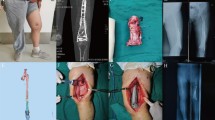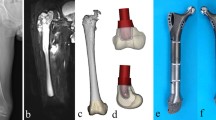Abstract
Five patients with segmental irregular-shaped bone defect of the femur were recruited in this study from 2017.12 to 2018.11. All patients were treated by customized design and 3D printed micro-porous prosthesis. And the procedure was divided into stages: radical debridement and temporary fixation (the first stage); the membrane formation and virtual surgery (intervening period for 6–8 weeks); definite reconstruction the defects (the second stage). Routine clinical follow-up and radiographic evaluation were done to assess bone incorporation and complications of internal fixation. The weight-bearing time and the joint function of the patients were recorded. The patients were followed up for an average of 16.4 months. The average length of bone defect and the distal residual bone was 12 cm and 6.5 cm. The average time of partial weight-bearing and full weight-bearing was 12.7 days and 2.6 months. X-ray demonstrated good osseous integration of the implant/bone interface. No complications occurred such as implant loosening, subsidence, loss of correction and infection. At the last follow-up, Harris score of hip joint was excellent in 2 cases, good in 2 cases, fair in 1 case; HSS score of knee joint was good in 4 cases, middle in 1 case. From our study, we concluded that meticulous customized design 3D printed micro-porous prosthesis combined with intramedullary nail may be a promising and an alternative strategy to treat metaphyseal segmental irregular-shaped femoral bone defect, especially for cases with massive juxta-articular bone loss.




Similar content being viewed by others
Data availability
The datasets used and/or analysed during the current study are available from the corresponding author on reasonable request.
Abbreviations
- PMMA:
-
Polymethyl Methacrylate
- CT:
-
computed tomography
- EMR:
-
electronic medical record
- IM:
-
intramedullary
- ROM:
-
range of motion
- A-P:
-
anterior-posterior
- L:
-
length
- T:
-
time
- DRB:
-
distal residual bone
- PWB:
-
partial weight bearing
- TWB:
-
total weight bearing
References
Reichert JC, Saifzadeh S, Wullschleger ME, Epari DR, Schütz MA, Duda GN, Schell H, Van Griensven M, Redl H, Hutmacher DW. The challenge of establishing preclinical models for segmental bone defect research. Biomaterials. 2009;30:2149–63.
Lindsey RW, Gugala Z, Milne E, Sun M, Gannon FH, Latta LL. The efficacy of cylindrical titanium mesh cage for the reconstruction of a critical-size canine segmental femoral diaphyseal defect. J Orthop Res. 2006;24:1438–53.
Mauffrey C, Barlow BT, Smith W. Management of segmental bone defects. J Am Acad Orthop Surg. 2015;23:143–53.
Attias N, Lehman RE, Bodell LS, Lindsey RW. Surgical management of a long segmental defect of the humerus using a cylindrical titanium mesh cage and plates. J Orthop Trauma. 2005;19:211–6.
Grant CA, Izatt MT, Labrom RD, Askin GN, Glatt V. Use of 3D printing in complex spinal surgery. Tech Orthop. 2016;31:172–80.
Tetsworth KD, Mettyas T. Overview of emerging technology in orthopedic surgery. Tech Orthop. 2016;31:143–52.
Song EK, Seon JK, Park SJ, Seo HY. Navigated open wedge high tibial osteotomy. Sports Med Arthrosc Rev. 2008;16:84–90.
Jun Y, Choi K. Design of patient-specific hip implants based on the 3D geometry of the human femur. Adv Eng Softw. 2010;41:537–47.
Buford WL, Turnbow BJ, Gugala Z, Lindsey RW. Three-dimensional computed tomography–based modeling of sagittal cadaveric femoral bowing and implications for intramedullary nailing. J Orthop Trauma. 2014;28:10–6.
Lu S, Zhang YZ, Wang Z, Shi JH, Chen YB, Xu XM, Xu YQ. Accuracy and efficacy of thoracic pedicle screws in scoliosis with patient-specific drill template. Med Biol Eng Comput. 2012;50:751–8.
Kataoka T, Oka K, Miyake J, Omori S, Tanaka H, Murase T. 3-dimensional prebent plate fixation in corrective osteotomy of malunited upper extremity fractures using a real-sized plastic bone model prepared by preoperative computer simulation. J Hand Surg. 2013;38:909–19.
Gouin F, Paul L, Odri GA, Cartiaux O. Computer-assisted planning and patient-specific instruments for bone tumor resection within the pelvis: a series of 11 patients. Sarcoma. 2014;2014:1–9.
Cobos JA, Lindsey RW, Gugala Z. The cylindrical titanium mesh cage for treatment of a long bone segmental defect: description of a new technique and report of two cases. J Orthop Trauma. 2000;14:54–9.
Tetsworth K, Block S, Glatt V. Putting 3D modelling and 3D printing into practice: virtual surgery and preoperative planning to reconstruct complex post-traumatic skeletal deformities and defects. SICOT-J. 2017;3:16.
Xu N, Wei F, Liu XG, Jiang L, Cai H, Li ZH, Yu M, Wu FL, Liu ZJ. Reconstruction of the upper cervical spine using a personalized 3D-printed vertebral body in an adolescent with ewing sarcoma. Spine. 2015;41:e50–4.
Yang J, Cai H, Lv J, Zhang K, Leng HJ, Sun CG, Wang ZG, Liu ZJ. In vivo study of a self-stabilizing artificial vertebral body fabricated by electron beam melting. Spine. 2014;39:E486–92.
Hamid KS, Parekh SG, Adams SB. Salvage of severe foot and ankle trauma with a 3D Printed Scaffold. Foot Ankle Int. 2016;37:433–9.
Sivakumar R, Mohideen MG, Chidambaram M, Vinoth T, Singhi PK, Somashekar V. Management of large bone defects in diaphyseal fractures by induced membrane formation by Masquelet’s technique. J Orthop Case Rep. 2016;6:59–62.
McBride-Gagyi S, Toth Z, Kim D, Lp V, Evans E, Watson JT, Nicolaou D. Altering spacer material affects bone regeneration in the Masquelet technique in a rat femoral defect. J Orthop Res. 2018;36:2228–38.
Gouron R, Petit L, Boudot C, Six L, Brazier M, Kamel S, Mentaverri R. Osteoclasts and their precursors are present in the induced-membrane during bone reconstruction using the Masquelet technique. J Tissue Eng Regen Med. 2017;11:382–9.
Taniguchi N, Fujibayashi S, Takemoto M, Sasaki K, Otsuki B, Nakamura T. Effect of pore size on bone ingrowth into porous titanium implants fabricated by additive manufacturing: an in vivo experiment. Mater Sci EngC. 2016;59:690–701.
Li JP, Habibovic P, van den Doel M, Wilson CE, Wijn JRD, Blitterswijk CAV. Bone ingrowth in porous titanium implants produced by 3D fiber deposition. Biomaterials. 2007;28:2810–20.
Gómez S, Vlad MD, López J, Fernández E. Design and properties of 3D scaffolds for bone tissue engineering. Acta Biomater. 2016;42:341–50.
Wang X, Xu S, Zhou S, Xu W, Leary M, Choong P, Qian M, Brandt M, Xie YM. Topological design and additive manufacturing of porous metals for bone scaffolds and orthopaedic implants: a review. Biomaterials. 2016;83:127–41.
Cao JM, Zhou YJ, Zhu QH. Elective Ilizarov bone transport technique in the treatment of infected tibial bone defect. J Pract Orthop. 2016;22:980–4.
Lacroix D, Prendergast PJ, Li G, Marsh D. Biomechanical model to simulate tissue differentiation and bone regeneration: application to fracture healing. Med Biol Eng Comput. 2002;40:14–21.
Xiu P, Jia Z, Lv J, Yin C, Cheng Y, Zhang K, Song C, Leng H, Zheng Y, Cai H, Liu Z. Tailored surface treatment of 3D printed porous Ti6Al4V by micro-arc oxidation for enhanced osseointegration via optimized bone in-growth patterns and interlocked bone/implant interface[J]. ACS Appl Mater Interf. 2016;8:17964–75.
Liu H, Hu G, Shang P, Shen Y, Nie P, Peng L, Xu H. Histological characteristics of induced membranes in subcutaneous, intramuscular sites and bone defect. Orthop Traumatol: Surg Res. 2013;99:959–64.
Gruber HE, Gettys FK, Montijo HE, Starman JS, Bayoumi E, Nelson KJ, Hoelscher GL, Ramp WK, Zinchenko N, Ingram JA, Bosse MJ, Kellam JF. Genomewide molecular and biologic characterization of biomembrane formation adjacent to a methacrylate spacer in the rat femoral segmental defect model. J Orthop Trauma. 2013;27:290–7.
Perren SM, Rahn BA. Biomechanics of fracture healing. Can J Surg J Canadien De Chirurgie. 1980;23:228–32.
Acknowledgements
The authors would like to thank Changdong Qiu for the help of design the implant and Xiaoyan Niu, the secretary, for a lot of image preparation and data transmission work, which ensured the smooth progress of the project.
Funding
This study was supported by Beijing Municipal Science & Technology Commission (Project Z181100001718195).
Authors’ contributions
GJH and BCL were involved in designing the prosthesis, acquisition of data, drafting the manuscript. YT, ZJL and FZ designed the study, revised the manuscript critically and gave some important suggestions; YT, HQJ, ZSZ, YG and YL made contributions to conception and design and performed the surgeries; ZWY completed the follow-up and collected the data. All authors read and approve the final manuscript.
Author information
Authors and Affiliations
Corresponding author
Ethics declarations
Conflict of interest
The authors declare that they have no conflict of interest.
Ethics approval
This study was approval by Peking University Third Hospital Human Research Ethical Committees with the number M2018174.
Consent to participate
All patients were informed preoperatively regarding the surgical purpose, management protocol, possible complications and recovery period. And informed consent was obtained from all participants.
Consent for publication
The consents for publication including any individual details, images with our institutional consent forms.
Additional information
Publisher’s note Springer Nature remains neutral with regard to jurisdictional claims in published maps and institutional affiliations.
Rights and permissions
About this article
Cite this article
Hou, G., Liu, B., Tian, Y. et al. An innovative strategy to treat large metaphyseal segmental femoral bone defect using customized design and 3D printed micro-porous prosthesis: a prospective clinical study. J Mater Sci: Mater Med 31, 66 (2020). https://doi.org/10.1007/s10856-020-06406-5
Received:
Accepted:
Published:
DOI: https://doi.org/10.1007/s10856-020-06406-5




